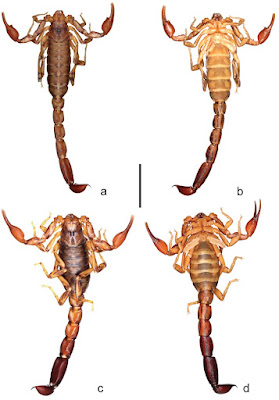 |
| Urophonius trewanke Ojanguren-Affilastro, Alfaro, Ramírez, Camousseigt-Montolivo & Pizarro-Araya, 2024 |
Abstract
Urophonius trewanke sp. nov. is described from the Mauline Andean woods of northern Chilean Patagonia. This species belongs to the granulatus species group, which includes the most basal species within the genus. This species is only active in summer as in all species of its group. We performed a phylogenetic analysis of the genus Urophonius based on morphological characters to establish the position and relationships of the new species in the genus.
Key Words: Bothriuridae, Chile, Mauline woods, new species, phylogeny
 |
| Urophonius trewanke sp. nov., a, b. Holotype ♂; c, d. Paratype ♀; a, c. Dorsal aspect; b, d. Ventral aspect. Scale bar: 10 mm. |
 |
| Habitat of Urophonius trewanke sp. nov., woods at Fundo La Escuadra, Maule Valley, Maule Region, Chile; |
 |
| b. Couple of Urophonius trewanke sp. nov. during courtship in its natural environment; c. Urophonius trewanke sp. nov. male, living specimen. |
Urophonius trewanke sp. nov.
Diagnosis: Urophonius trewanke sp. nov. is most closely related to U. tregualemuensis from south-central Chile (Fig. 2a). Both species can be easily separated by their pigment pattern; in U. trewanke sp. nov. the dorso-submedian spots of tergites are poorly developed, being reduced to small triangles in the posterior half of the segment (Figs 4a, 5a), whereas in U. tregualemuensis, these spots are much more developed, occupying almost the whole median part of the segment (Fig. 5b).
...
Etymology: The specific epithet “trewanke” is a noun in apposition meaning scorpion in Mapungudun, the language of the Mapuche people, the original inhabitants from most parts of southern and central Chile.
Andrés A. Ojanguren-Affilastro, Fermín M. Alfaro, Martín J. Ramírez, Bernardino Camousseigt-Montolivo and Jaime Pizarro-Araya. 2024. A New Species of Genus Urophonius Pocock, 1893 (Scorpiones, Bothriuridae), from Andean Mauline Chilean Forests, with a phylogenetic re-analysis of the Genus. Zoosystematics and Evolution. 100(2): 469-482. DOI: 10.3897/zse.100.119153
